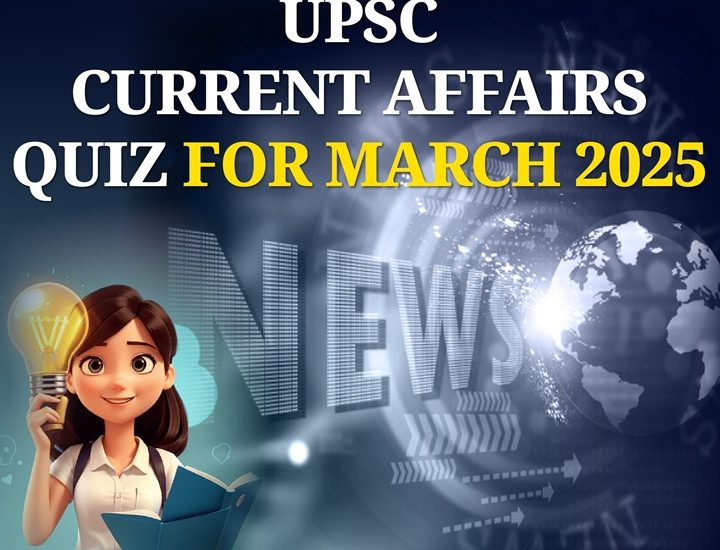
Present Affairs Quiz 29 March 2025
Present Affairs Quiz 29 March 2025
Data
Present Affairs Quiz 29 March 2025 For UPSC Examination
You’ve already accomplished the quiz earlier than. Therefore you cannot begin it once more.
You will need to register or signal as much as begin the quiz.
You must end following quiz, to begin this quiz:
-
Query 1 of 5
Contemplate the next statements relating to Freedom of Speech and Expression in India:
1. It’s an absolute proper underneath Article 19(1)(a) of the Structure.
2. It’s topic to affordable restrictions talked about underneath Article 19(2).
Which of the statements given above is/are appropriate?AppropriateReply: (b) 2 solely
Rationalization: Freedom of Speech and Expression underneath Article 19(1)(a) isn’t absolute. It’s topic to affordable restrictions underneath Article 19(2) in issues of safety of the state, public order, decency, morality, defamation, incitement to offense, sovereignty, and integrity of India, and so forth.
IncorrectReply: (b) 2 solely
Rationalization: Freedom of Speech and Expression underneath Article 19(1)(a) isn’t absolute. It’s topic to affordable restrictions underneath Article 19(2) in issues of safety of the state, public order, decency, morality, defamation, incitement to offense, sovereignty, and integrity of India, and so forth.
-
Query 2 of 5
The Carriage of Items by Sea Invoice, 2024, was handed within the Lok Sabha to exchange which of the next acts?
AppropriateReply: (b) The Indian Carriage of Items by Sea Act, 1925
Rationalization: The Carriage of Items by Sea Invoice, 2024, replaces the Indian Carriage of Items by Sea Act, 1925, to modernize maritime commerce laws and align them with world requirements.
IncorrectReply: (b) The Indian Carriage of Items by Sea Act, 1925
Rationalization: The Carriage of Items by Sea Invoice, 2024, replaces the Indian Carriage of Items by Sea Act, 1925, to modernize maritime commerce laws and align them with world requirements.
-
Query 3 of 5
What initiative has CBSE launched to strengthen parent-child-school collaboration?
AppropriateReply: (c) Parenting Calendar Initiative
Rationalization: CBSE launched the Parenting Calendar Initiative to offer structured steering and assets for folks, aligning with NEP 2020.
IncorrectReply: (c) Parenting Calendar Initiative
Rationalization: CBSE launched the Parenting Calendar Initiative to offer structured steering and assets for folks, aligning with NEP 2020.
-
Query 4 of 5
Contemplate the next statements relating to the Manufacturing-Linked Incentive (PLI) scheme:
1. It goals to spice up home manufacturing by offering monetary incentives based mostly on incremental gross sales.
2. The scheme is relevant solely to the electronics and semiconductor sectors.
Which of the statements given above is/are appropriate?AppropriateReply: (a) 1 solely
Rationalization:
• The PLI scheme is designed to advertise home manufacturing by providing monetary incentives based mostly on incremental gross sales of products produced in India.
• Whereas it initially began with electronics, it now covers a number of sectors like cars, textiles, prescribed drugs, drones, photo voltaic modules, and so forth. Therefore, Assertion 2 is wrong.IncorrectReply: (a) 1 solely
Rationalization:
• The PLI scheme is designed to advertise home manufacturing by providing monetary incentives based mostly on incremental gross sales of products produced in India.
• Whereas it initially began with electronics, it now covers a number of sectors like cars, textiles, prescribed drugs, drones, photo voltaic modules, and so forth. Therefore, Assertion 2 is wrong. -
Query 5 of 5
Which sector is predicted to be probably the most affected if the U.S. imposes retaliatory tariffs on Indian exports?
AppropriateReply: (d) Agriculture
Rationalization: India imposes a 40% common tariff on U.S. agricultural imports, whereas the U.S. imposes solely 2.9% on Indian agricultural exports. Retaliatory tariffs might hit Indian agricultural exports the toughest.
IncorrectReply: (d) Agriculture
Rationalization: India imposes a 40% common tariff on U.S. agricultural imports, whereas the U.S. imposes solely 2.9% on Indian agricultural exports. Retaliatory tariffs might hit Indian agricultural exports the toughest.
Leave a Reply